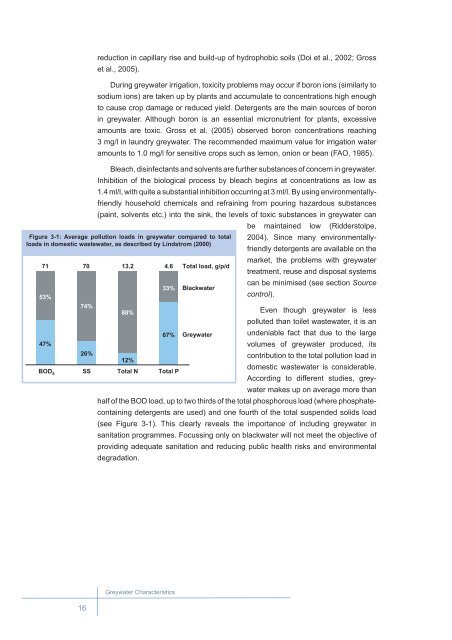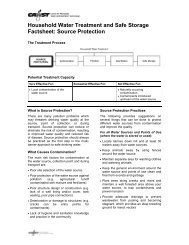Greywater Management in Low and Middle-Income Countries - SSWM
Greywater Management in Low and Middle-Income Countries - SSWM
Greywater Management in Low and Middle-Income Countries - SSWM
Create successful ePaper yourself
Turn your PDF publications into a flip-book with our unique Google optimized e-Paper software.
eduction <strong>in</strong> capillary rise <strong>and</strong> build-up of hydrophobic soils (Doi et al., 2002; Gross<br />
et al., 2005).<br />
Dur<strong>in</strong>g greywater irrigation, toxicity problems may occur if boron ions (similarly to<br />
sodium ions) are taken up by plants <strong>and</strong> accumulate to concentrations high enough<br />
to cause crop damage or reduced yield. Detergents are the ma<strong>in</strong> sources of boron<br />
<strong>in</strong> greywater. Although boron is an essential micronutrient for plants, excessive<br />
amounts are toxic. Gross et al. (2005) observed boron concentrations reach<strong>in</strong>g<br />
3 mg/l <strong>in</strong> laundry greywater. The recommended maximum value for irrigation water<br />
amounts to 1.0 mg/l for sensitive crops such as lemon, onion or bean (FAO, 1985).<br />
Bleach, dis<strong>in</strong>fectants <strong>and</strong> solvents are further substances of concern <strong>in</strong> greywater.<br />
Inhibition of the biological process by bleach beg<strong>in</strong>s at concentrations as low as<br />
1.4 ml/l, with quite a substantial <strong>in</strong>hibition occurr<strong>in</strong>g at 3 ml/l. By us<strong>in</strong>g environmentallyfriendly<br />
household chemicals <strong>and</strong> refra<strong>in</strong><strong>in</strong>g from pour<strong>in</strong>g hazardous substances<br />
(pa<strong>in</strong>t, solvents etc.) <strong>in</strong>to the s<strong>in</strong>k, the levels of toxic substances <strong>in</strong> greywater can<br />
be ma<strong>in</strong>ta<strong>in</strong>ed low (Ridderstolpe,<br />
2004). S<strong>in</strong>ce many environmentallyfriendly<br />
<br />
detergents are available on the<br />
market, the problems with greywater<br />
71 70 13.2 4.6 Total load, g/p/d<br />
treatment, reuse <strong>and</strong> disposal systems<br />
can be m<strong>in</strong>imised (see section Source<br />
33% Blackwater<br />
53%<br />
control).<br />
74%<br />
88%<br />
Even though greywater is less<br />
polluted than toilet wastewater, it is an<br />
67% <strong>Greywater</strong> undeniable fact that due to the large<br />
47%<br />
volumes of greywater produced, its<br />
26%<br />
contribution to the total pollution load <strong>in</strong><br />
12%<br />
domestic wastewater is considerable.<br />
BOD 5<br />
SS Total N Total P<br />
Accord<strong>in</strong>g to different studies, greywater<br />
makes up on average more than<br />
half of the BOD load, up to two thirds of the total phosphorous load (where phosphateconta<strong>in</strong><strong>in</strong>g<br />
detergents are used) <strong>and</strong> one fourth of the total suspended solids load<br />
(see Figure 3-1). This clearly reveals the importance of <strong>in</strong>clud<strong>in</strong>g greywater <strong>in</strong><br />
sanitation programmes. Focuss<strong>in</strong>g only on blackwater will not meet the objective of<br />
provid<strong>in</strong>g adequate sanitation <strong>and</strong> reduc<strong>in</strong>g public health risks <strong>and</strong> environmental<br />
degradation.<br />
16<br />
<strong>Greywater</strong> Characteristics
















